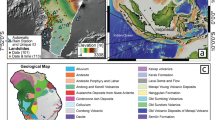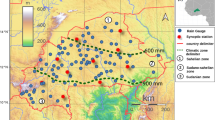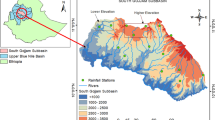Abstract
Extreme rainfall events are a serious threat to the well-being of Cameroon’s society. The reliability of studies on extreme events such as floods depends on the quality of the data and their distribution in time and space. Although these topics are still incomplete in many African countries, the present work focuses on the action of extreme rainfall variability and changes on ground traffic in Cameroon using the Climate Hazards Group InfraRed Precipitation with Station data (CHIRPS) estimation data in the simulation of precipitation at the intra-seasonal scale. For this purpose, the performance assessment of the CFSv2 model was first made on the basis of two mathematical techniques such as the Generalized Relative Operating Characteristics (GROC) score and the Ranked Probability Skill Score (RPSS). Then, based on this calculation of the different performance scores, the analysis and interpretations of the model outputs, the study is carried out on the extreme events (floods) of the first 3 weeks of August 2021 to understand the impact of extreme rainfall over road transport in Cameroon. The results suggest that the CFSv2 model is the best performance for rainfall simulation at this intra-seasonal scale with CHIRPS satellite estimation data for the first 3 weeks of August 2021 in Cameroon and is adequate to improve the prevention of accidents and road transportation infrastructure caused by extreme events (flooding) to heavy rainfall in Cameroon.







Similar content being viewed by others
Data availability
We have the materials, all the raw and processed data and result products. We can provide the processed data and documents if it is required.
Code availability
The tools used in this work included the CHIRPS estimation data in the simulation of precipitation at the intra-seasonal scale and the CFSv2 model for the analysis and interpretations of the model outputs.
References
Annuaire Statistique du Cameroun (2015) Institut National de la Statistique, Edition 2015
Daïka A, Mbane BC (2015) Relationship between sea surface single carrier waves and decreasing pressures of atmosphere lower boundary. Open J Mar Sci 5:45–54. https://doi.org/10.4236/ojms.2015.51005
Daïka A, Igri MP, Oumarou MM, Mbane BC (2022) Analysis of weather conditions for aerial security and optimization in Maroua-Salak. Atmos Clim Sci 12(1):172–188. https://doi.org/10.4236/acs.2022.121012
Daïka A, Igri MP, Taguemfo KJ, Fita DE et al (2023) Impact assessment of the West African Monsoon on convective precipitations over the far north region of Cameroon. Adv Space Res 72(3):666–676. https://doi.org/10.1016/j.asr.2022.04.044
Das A, Ghasemzadeh A, Ahmed MM (2019) Analyzing the effect of fog weather conditions on driver lane-keeping performance using the SHRP2 naturalistic driving study data. J Saf Res 68:71–80
Dinku T, Funk C, Peterson P, Maidment R et al (2018) Validation of the CHIRPS satellite rainfall estimates over Eastern Africa. Q J R Meteorol Soc 144:292–312
Douglas I, Alam K, Maghenda M, McDonnell Y et al (2008) Unjust waters: climate change, flooding and the poor in Africa. Environ Urban 20:187–205. https://doi.org/10.1177/0956247808089156
DSCE (2009) Cadre de référence de l’action gouvernementale pour la période 2010–2020, Document de Stratégies pour la Croissance et l'Emploi, p 174
Engel T, Andreas HF, Knippertz P, Pante G, Bliefernicht J (2017) Extreme precipitation in the West African cities of Dakar and Ouagadougou: atmospheric dynamics and implications for flood risk assessments. J Hydrometeorol 18:2937–2957
Griffies S M, Harrison M J, Pacanowski R C, Rosati A R et al (2004) A technical guide to MOM4. GFDL Ocean Group Tech. Rep 5, p 342. Available online at http://www.gfdl.noaa.gov/bibliography/related_files/smg0301.pdf
Hardoy JE, Mitlin D, Satterthwaite D (2001) Environmental problems in an urbanizing world: finding solutions in cities in Africa, Asia and Latin America. Earthscan, p 464
Katsanos D, Retalis A, Michaelides S (2016) Validation of a high-resolution precipitation database (CHIRPS) over Cyprus for a 30-year period. Atmos Res 169:459–464
Kingtse CM, Shukla S, Lettenmaier DP, Li-Chuan C (2012) Do Climate forecast system (CFSv2) forecasts improve seasonal soil moisture prediction? Geophys Res Lett 39:L23703. https://doi.org/10.1029/2012GL053598
Kumar S, Dirmeyer PA, Kinter JL III (2014) Usefulness of ensemble forecasts from NCEP climate forecast system in sub-seasonal to intra-annual forecasting. Geophys Res Lett 41:3586–3593. https://doi.org/10.1002/2014GL059586
Lei B, Chunxiang S, Lanhai L, Yanfen Y, Jing W (2018) Accuracy of CHIRPS satellite-rainfall products over Mainland China. Remote sensing 10:362. https://doi.org/10.3390/rs10030362
Lensen NJL, Lisa G, Simon M (2020) Seasonal forecast skill of ENSO teleconnection maps. Weather Forecast 35:2387–2406
Marjorie M, Scott S, Peterson TC, Pisano P (2009) Les implications des changements de conditions météorologiques et climatiques pour le transport de surface aux Etats-Unis d’Amérique, Bulletin de l’OMM 58(2)
Mason SJ (2018) Guidance on verification of operational seasonal climate forecasts. WMO 1220, p 81. https://library.wmo.int/doc_num.php?explnum_id54886
Mboka JJM, Kouna BS, Chouto S, Djuidje KF et al (2020) Simulated impact of global warming on extreme rainfall events over Cameroon during the 21st century. Weather 76(10):347–353. https://doi.org/10.1002/wea.3867
MINEPDED (2015) Second national communication on climate change 36
Molua E (2006) Climatic trends in Cameroon: implications for agricultural management. Clim Res 30:255–262
Nchito WS (2007) Flood risk in unplanned settlements in Lusaka. Environ Urban 19:539–551. https://doi.org/10.1177/0956247807082835
Nguessan KJ, Kane R, Kabanguka JK (2015) Cameroun, Note sur le secteur des transports, Groupe de la banque africaine de développement, Département des transports, du développement urbain et des TIC, p 44
Nicholson SE, Some B, Mccollum J, Nelkin E et al (2003) Validation of TRMM and other rainfall estimates with a high-density gauge dataset for West Africa. Part I: validation of GPCC rainfall product and pre-TRMM satellite and blended products. J Appl Meteor 42:1337–1354. https://doi.org/10.1175/1520-0450(2003)042,1337:VOTAOR.2.0.CO;2
Nour-Eddin EF, Buton J, Billot R (2013) Effects of adverse weather conditions on traffic demand. Rech Transp Secur 29:21–46
OMM No 1275 (2021) État du climat en Afrique 2020. Organisation mondiale de la météorologique, p 42
Paredes-Trejo FJ, Barbosa HA, Kumar TV (2017) Validating CHIRPS-based satellite precipitation estimates in Northeast Brazil. J Arid Environ 139:26–40
Prevedouros PD, Kongsil P (2003) Synthesis of the effects of wet conditions on highway speed and capacity. University of Hawaii-Manoa, Department of Civil Engineering, p 19
Rahman A, Lownes NE (2012) Analysis of rainfall impacts on platooned vehicle spacing and speed. Transp Res Part F Traffic Psychol Behav 15:395–403
Rosseti MA (2002) Potential impacts of climate change on rail roads. In “The potential impacts of Climate change on Transportation: Workshop Summary. US Dept. of Transportation, Workshop, 1st-2 October . http://climate.volpe.dot.gov/workshop1002/”
Saha S, Shrinivas M, Hua-Lu P, Xingren W et al (2010) The NCEP climate forecast system reanalysis. Bull Amer Meteor Soc 91:1015–1057. https://doi.org/10.1175/2010BAMS3001.1
Saha S, Shrinivas M, Xingren W, Jiande W et al (2014) The NCEP climate forecast system version 2. J Climate 27:2185–2208. https://doi.org/10.1175/JCLI-D-12-00823.1
Sakhare RS, Zhang Y, Li H, Bullock DM (2023) Impact of rain intensity on interstate traffic speeds using connected vehicle data. Vehicles 5:133–155. https://doi.org/10.3390/vehicles5010009
Shuhua L, Andrew WR (2015) Evaluation of submonthly precipitation forecast skill from global ensemble prediction systems. Mon Wea Review 143:2871–2889
Siti A, Tangang F, Sheau TN, Juneng L (2019) Prediction skill of NCEP CFSv2 for seasonal precipitation and surface air temperature forecast over southeast Asia. Sains Malaysiana 48(11):2325–2334. https://doi.org/10.17576/jsm-2019-4811-04
Suchel J-B (1987) Les climats du Cameroun, Thèse de Doctorat d'État, Université de Bordeaux III, France, 3, 1, p 186
Transtat (2000) Bulletin Statistique des Transports 2000, Ministère des Transports
Vondou DA, Yepdo ZD, Djiotang TLA (2018) Diurnal cycle of convective cloud occurrences over Cameroon during June–August. J Indian Soc Rem Sens. https://doi.org/10.1007/s12524-017-0747-x
Vondou DA, Guenang GM, Djiotang TLA, Kamsu-Tamo PH (2021) Trends and interannual variability of extreme rainfall indices over Cameroon. Sustainability 13:6803. https://doi.org/10.3390/su13126803
Wang P, Zhang Y, Wang S, Li L, Li X (2021) Forecasting travel speed in the rainfall days to develop suitable variable speed limits control strategy for less driving risk. J Adv Transp 2021:6637584
Xing Y, Wood EF, Lifeng L, Ming P (2011) A first look at climate forecast system version 2 (CFSv2) for hydrological seasonal prediction. Geophys Res Lett 38:L13402. https://doi.org/10.1029/2011GL047792
Zhang J, Song G, Gong D, Gao Y, Yu L, Guo J (2018) Analysis of rainfall effects on road travel speed in Beijing, China. IET Intell Transp Syst 12:93–102
Acknowledgements
The authors thank the anonymous reviewers and editors for their valuable comments and suggestions for improving and accepting the paper.
Funding
This study was funded by the authors.
Author information
Authors and Affiliations
Contributions
DA: investigation, conceptualization, visualization, and writing—original draft and formal analysis; IMP: investigation, data curation, methodology, visualization and software; MEH and MBC: validation, writing, supervision, review and editing.
Corresponding author
Ethics declarations
Ethics approval
Not applicable to this paper because there was no potential conflict of interest.
Consent to participate
Not applicable to this paper.
Consent for publication
The submission of this paper has been approved by all relevant authors and is the independent work of the authors. The authors have seen and agreed to the submitted version of the paper. It has not been submitted and not published or accepted for publication and is not under consideration for publication in another journal or book.
Competing interests
The authors declare no competing interests.
Additional information
Publisher's Note
Springer Nature remains neutral with regard to jurisdictional claims in published maps and institutional affiliations.
Rights and permissions
Springer Nature or its licensor (e.g. a society or other partner) holds exclusive rights to this article under a publishing agreement with the author(s) or other rightsholder(s); author self-archiving of the accepted manuscript version of this article is solely governed by the terms of such publishing agreement and applicable law.
About this article
Cite this article
Augustin, D., Pascal, I.M., Honoré, M.E. et al. Impact of extreme rainfall variability and changes on ground traffic in Cameroon. Theor Appl Climatol 155, 3175–3185 (2024). https://doi.org/10.1007/s00704-023-04801-w
Received:
Accepted:
Published:
Issue Date:
DOI: https://doi.org/10.1007/s00704-023-04801-w




